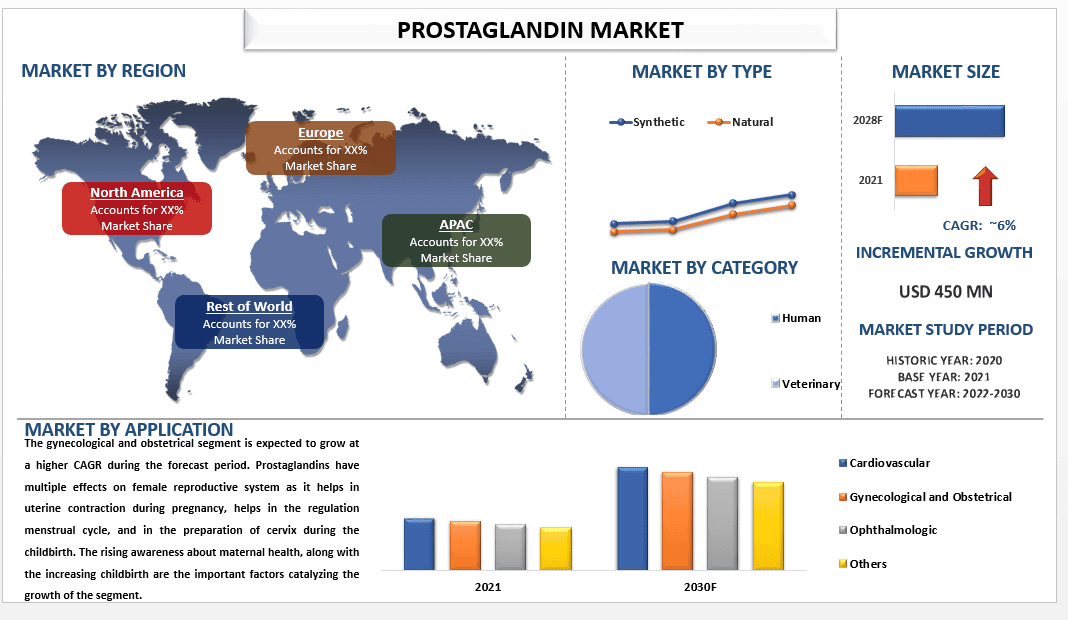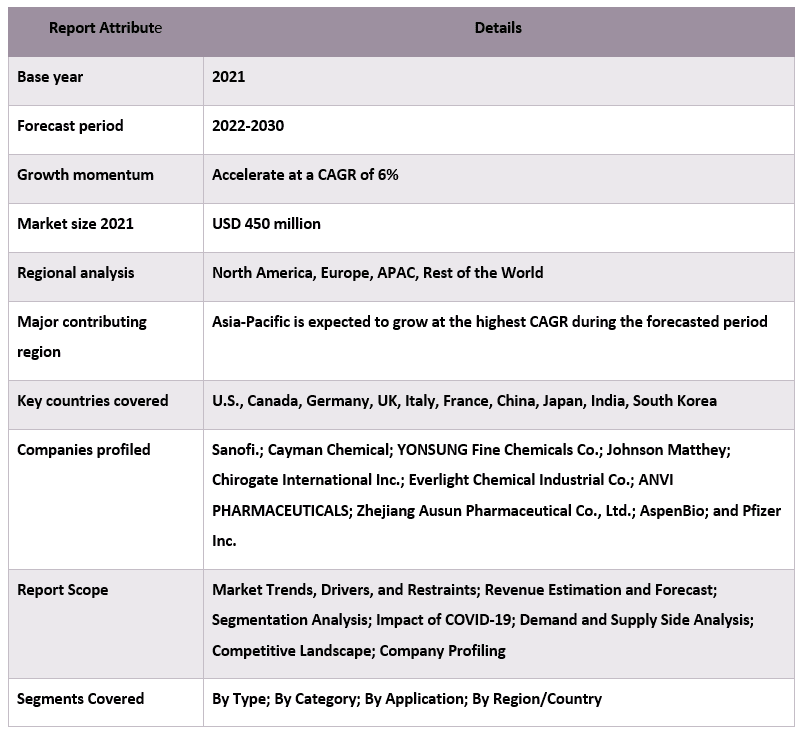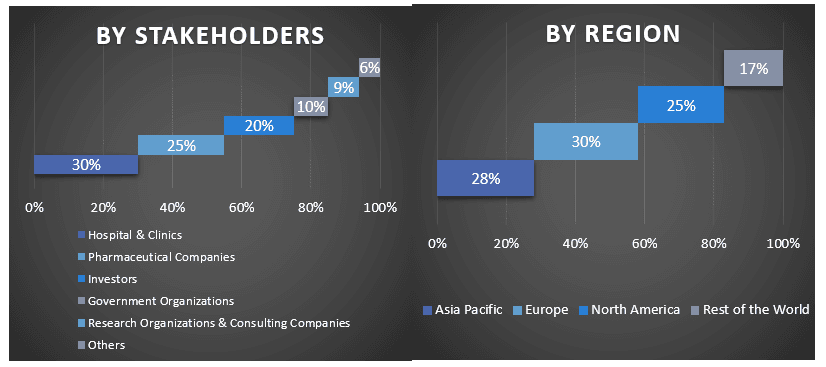- الرئيسية
- معلومات عنا
- صناعة
- الخدمات
- قراءة
- اتصل بنا
سوق البروستاجلاندين: التحليل الحالي والتوقعات (2022-2030)
التركيز على النوع (الدواء الأصلي والدواء الجنيس)؛ المستخدم النهائي (المستشفيات والعيادات وغيرها)؛ والمنطقة/الدولة

بلغت قيمة سوق البروستاجلاندين 450 مليون دولار ومن المتوقع أن ينمو بمعدل نمو سنوي مركب قوي يبلغ حوالي 6٪ خلال الفترة المتوقعة (2022-2030). البروستاجلاندين هي مواد شبيهة بالهرمونات تشارك في العديد من العمليات الفسيولوجية في الجسم، بما في ذلك الالتهاب والألم وتخثر الدم. يتم استخدامها في مجموعة متنوعة من التطبيقات الطبية، بما في ذلك علاج الجلوكوما وضعف الانتصاب وبعض اضطرابات الجهاز الهضمي. يعزى نمو سوق البروستاجلاندين بشكل أساسي إلى الطلب المتزايد على العلاج الفعال للأمراض مع الحد الأدنى من الآثار الجانبية. علاوة على ذلك، فإن زيادة مرافق الإنتاج من قبل اللاعبين الرئيسيين في السوق تعزى أيضًا إلى نمو سوق البروستاجلاندين. على سبيل المثال، في يناير 2023، بدأت شركة Sanofi إنتاجها من البروستاجلاندين في بودابست، المجر. يستخدم عنصر الدواء بشكل أساسي لمنتجات طب العيون ويمثل علامة مميزة لعلاج الجلوكوما.
بعض اللاعبين الرئيسيين العاملين في السوق تشمل Sanofi.؛ Cayman Chemical؛ YONSUNG Fine Chemicals Co.؛ Johnson Matthey؛ Chirogate International Inc.؛ Everlight Chemical Industrial Co.؛ Merck KGaA؛ Zhejiang Ausun Pharmaceutical Co., Ltd.؛ AspenBio؛ و Pfizer Inc. وقد قام هؤلاء اللاعبون بالعديد من عمليات الاندماج والاستحواذ بالإضافة إلى الشراكات لتزويد العملاء بمنتجات/تقنيات عالية التقنية ومبتكرة.
رؤى مقدمة في التقرير
"من بين الأنواع، من المتوقع أن ينمو الجزء الطبيعي بمعدل نمو سنوي مركب أعلى خلال الفترة المتوقعة."
استنادًا إلى النوع، يتم تقسيم السوق إلى اصطناعي وطبيعي. وفقًا لتحليلنا، من المتوقع أن ينمو الجزء الطبيعي بمعدل نمو سنوي مركب أعلى خلال الفترة المتوقعة. البروستاجلاندين الطبيعية هي مكملات غذائية أو طبيعية تحتوي على البروستاجلاندين مثل الأعشاب وكبد السمك وغيرها. الطلب المتزايد على الأدوية الطبيعية والعضوية هو السبب الرئيسي للنمو السريع لقطاع البروستاجلاندين الطبيعي.
"من بين الفئات، استحوذ الجزء البشري على الحصة المهيمنة في عام 2021."
استنادًا إلى الفئة، يتم تقسيم السوق إلى بشري وبيطري. وفقًا لتحليلنا، استحوذ الجزء البشري على الحصة المهيمنة في عام 2021. إن الارتفاع المتزايد في الأمراض المزمنة، جنبًا إلى جنب مع النمو السكاني السريع للبشر على مستوى العالم هو السبب الرئيسي للحصة المهيمنة لقطاع البروستاجلاندين البشري في السوق. علاوة على ذلك، فإن الانتشار المتزايد للالتهابات بين السكان من البشر هو أيضًا عامل يساهم في هيمنة هذا القطاع.
"من بين التطبيقات، من المتوقع أن ينمو الجزء الطبيعي بمعدل نمو سنوي مركب أعلى خلال الفترة المتوقعة."
استنادًا إلى التطبيق، يتم تقسيم السوق إلى أمراض القلب والأوعية الدموية، وأمراض النساء والتوليد، وطب العيون، وغيرها. وفقًا لتحليلنا، من المتوقع أن ينمو قطاع أمراض النساء والتوليد بمعدل نمو سنوي مركب أعلى خلال الفترة المتوقعة. البروستاجلاندين لها آثار متعددة على الجهاز التناسلي الأنثوي لأنها تساعد في تقلصات الرحم أثناء الحمل، وتساعد في تنظيم الدورة الشهرية، وفي تحضير عنق الرحم أثناء الولادة. إن الوعي المتزايد بصحة الأم، إلى جانب الزيادة في الولادات هي عوامل مهمة تحفز نمو القطاع.
تغطية تقرير سوق البروستاجلاندين

"من المتوقع أن تنمو منطقة آسيا والمحيط الهادئ بأعلى معدل نمو سنوي مركب في سوق البروستاجلاندين خلال الفترة المتوقعة."
من المتوقع أن تنمو منطقة آسيا والمحيط الهادئ بأعلى معدل نمو سنوي مركب في سوق البروستاجلاندين خلال الفترة المتوقعة بسبب عدد سكانها الكبير وأمراض العظام في المنطقة هي عوامل رئيسية تساهم في نمو سوق البروستاجلاندين في المنطقة. على سبيل المثال، وفقًا للمؤسسة الدولية لهشاشة العظام، يعاني حوالي 13 مليون شخص في اليابان من هشاشة العظام. تسبب أمراض العظام كسور هشاشة مؤلمة ومعيقة، مما يؤدي غالبًا إلى فقدان طويل الأجل للحركة والاستقلالية لدى كبار السن.
أسباب شراء هذا التقرير:
- تتضمن الدراسة تحليل حجم السوق والتنبؤ به تم التحقق منه من قبل خبراء الصناعة الرئيسيين الموثوق بهم.
- يقدم التقرير مراجعة سريعة للأداء العام للصناعة في لمحة.
- يغطي التقرير تحليلًا متعمقًا لأقران الصناعة البارزين مع التركيز الأساسي على البيانات المالية الرئيسية للأعمال، ومحافظ المنتجات، واستراتيجيات التوسع، والتطورات الأخيرة.
- دراسة تفصيلية للدوافع والقيود والاتجاهات الرئيسية والفرص السائدة في الصناعة.
- تغطي الدراسة بشكل شامل السوق عبر قطاعات مختلفة.
- تحليل متعمق على المستوى الإقليمي للصناعة.
خيارات التخصيص:
يمكن تخصيص سوق البروستاجلاندين العالمي بشكل أكبر وفقًا للمتطلبات أو أي قطاع آخر من السوق. إلى جانب ذلك، تتفهم UMI أن لديك احتياجات عمل خاصة بك، لذا لا تتردد في التواصل معنا للحصول على تقرير يناسب متطلباتك تمامًا.
جدول المحتويات
منهجية البحث لتحليل سوق البروستاجلاندين (2022-2030)
كان تحليل السوق التاريخي، وتقدير السوق الحالي، والتنبؤ بالسوق المستقبلي لسوق البروستاجلاندين العالمي هي الخطوات الرئيسية الثلاث التي تم اتخاذها لإنشاء وتحليل اعتماد البروستاجلاندين في المناطق الرئيسية على مستوى العالم. تم إجراء بحث ثانوي شامل لجمع أرقام السوق التاريخية وتقدير حجم السوق الحالي. ثانيًا، للتحقق من صحة هذه الرؤى، تم أخذ العديد من النتائج والافتراضات في الاعتبار. علاوة على ذلك، تم إجراء مقابلات أولية شاملة مع خبراء الصناعة عبر سلسلة القيمة لسوق البروستاجلاندين العالمي. بعد افتراض أرقام السوق والتحقق من صحتها من خلال المقابلات الأولية، استخدمنا نهجًا من أعلى إلى أسفل/من أسفل إلى أعلى للتنبؤ بحجم السوق الكامل. بعد ذلك، تم اعتماد طرق تقسيم السوق وتثليث البيانات لتقدير وتحليل حجم سوق القطاعات والقطاعات الفرعية المتعلقة بالصناعة. يتم شرح المنهجية التفصيلية أدناه:
تحليل حجم السوق التاريخي
الخطوة 1: دراسة متعمقة للمصادر الثانوية:
تم إجراء دراسة ثانوية تفصيلية للحصول على حجم السوق التاريخي لسوق البروستاجلاندين من خلال مصادر الشركة الداخلية مثل التقارير السنوية والبيانات المالية والعروض التقديمية للأداء والنشرات الصحفية وما إلى ذلك، والمصادر الخارجية بما في ذلك المجلات والأخبار والمقالات والمنشورات الحكومية ومنشورات المنافسين وتقارير القطاعات وقاعدة بيانات الطرف الثالث والمنشورات الموثوقة الأخرى.
الخطوة 2: تقسيم السوق:
بعد الحصول على حجم السوق التاريخي لسوق البروستاجلاندين، أجرينا تحليلًا ثانويًا تفصيليًا لجمع رؤى السوق التاريخية والحصص للقطاعات والقطاعات الفرعية المختلفة للمناطق الرئيسية. يتم تضمين القطاعات الرئيسية في التقرير كنوع وفئة وتطبيق. علاوة على ذلك، تم إجراء تحليلات على مستوى الدولة لتقييم الاعتماد العام لنماذج الاختبار في تلك المنطقة.
الخطوة 3: تحليل العوامل:
بعد الحصول على حجم السوق التاريخي للقطاعات والقطاعات الفرعية المختلفة، أجرينا تحليلًا تفصيليًا للعوامل لتقدير حجم السوق الحالي لسوق البروستاجلاندين. علاوة على ذلك، أجرينا تحليلًا للعوامل باستخدام متغيرات تابعة ومستقلة مثل النوع والفئة والتطبيق لسوق البروستاجلاندين. تم إجراء تحليل شامل لسيناريوهات جانب الطلب والعرض مع الأخذ في الاعتبار أهم الشراكات وعمليات الاندماج والاستحواذ والتوسع التجاري وإطلاق المنتجات في قطاع سوق البروستاجلاندين في جميع أنحاء العالم.
تقدير حجم السوق الحالي والتنبؤ به
تحديد حجم السوق الحالي: بناءً على رؤى قابلة للتنفيذ من الخطوات الثلاث المذكورة أعلاه، توصلنا إلى حجم السوق الحالي واللاعبين الرئيسيين في سوق البروستاجلاندين العالمي والحصص السوقية للقطاعات. تم تحديد جميع تقسيمات الأسهم المئوية المطلوبة وتقسيمات السوق باستخدام النهج الثانوي المذكور أعلاه وتم التحقق منها من خلال المقابلات الأولية.
التقدير والتنبؤ: لتقدير السوق والتنبؤ به، تم تخصيص أوزان لعوامل مختلفة بما في ذلك المحركات والاتجاهات والقيود والفرص المتاحة لأصحاب المصلحة. بعد تحليل هذه العوامل، تم تطبيق تقنيات التنبؤ ذات الصلة، أي النهج من أعلى إلى أسفل/من أسفل إلى أعلى للوصول إلى توقعات السوق لعام 2030 للقطاعات والقطاعات الفرعية المختلفة عبر الأسواق الرئيسية على مستوى العالم. تتضمن منهجية البحث المعتمدة لتقدير حجم السوق ما يلي:
- حجم سوق الصناعة، من حيث الإيرادات (بالدولار الأمريكي) ومعدل اعتماد سوق البروستاجلاندين عبر الأسواق الرئيسية محليًا
- جميع الحصص المئوية وتقسيمات وتفصيلات قطاعات السوق والقطاعات الفرعية
- اللاعبون الرئيسيون في سوق البروستاجلاندين العالمي من حيث المنتجات المعروضة. أيضًا، استراتيجيات النمو التي يتبناها هؤلاء اللاعبون للتنافس في السوق سريع النمو
التحقق من صحة حجم السوق وحصته
البحث الأولي: تم إجراء مقابلات متعمقة مع قادة الرأي الرئيسيين (KOLs) بما في ذلك كبار المديرين التنفيذيين (CXO/VPs، رئيس المبيعات، رئيس التسويق، الرئيس التشغيلي، الرئيس الإقليمي، رئيس الدولة، وما إلى ذلك) عبر المناطق الرئيسية. ثم تم تلخيص نتائج البحث الأولي، وتم إجراء تحليل إحصائي لإثبات الفرضية المذكورة. تم دمج المدخلات من البحث الأولي مع النتائج الثانوية، وبالتالي تحويل المعلومات إلى رؤى قابلة للتنفيذ.
تقسيم المشاركين الأساسيين في مناطق مختلفة

هندسة السوق
تم استخدام تقنية تثليث البيانات لإكمال تقدير السوق الإجمالي والوصول إلى أرقام إحصائية دقيقة لكل قطاع فرعي من قطاعات سوق البروستاجلاندين العالمي. تم تقسيم البيانات إلى عدة قطاعات وقطاعات فرعية بعد دراسة المعايير والاتجاهات المختلفة في مجالات النوع والفئة والتطبيق في سوق البروستاجلاندين العالمي.
الهدف الرئيسي لدراسة سوق البروستاجلاندين العالمي
تم تحديد اتجاهات السوق الحالية والمستقبلية لسوق البروستاجلاندين العالمي في الدراسة. يمكن للمستثمرين اكتساب رؤى استراتيجية لارتكاز تقديرهم للاستثمارات على التحليل النوعي والكمي الذي تم إجراؤه في الدراسة. حددت اتجاهات السوق الحالية والمستقبلية الجاذبية الإجمالية للسوق على المستوى الإقليمي، مما يوفر منصة للمشارك الصناعي لاستغلال السوق غير المستغلة للاستفادة من ميزة السبق. تشمل الأهداف الكمية الأخرى للدراسات ما يلي:
- تحليل حجم السوق الحالي والمتوقع لسوق البروستاجلاندين من حيث القيمة (بالدولار الأمريكي). أيضًا، قم بتحليل حجم السوق الحالي والمتوقع للقطاعات والقطاعات الفرعية المختلفة
- تشمل القطاعات في الدراسة مجالات النوع والفئة والتطبيق.
- تحديد وتحليل الإطار التنظيمي لصناعة البروستاجلاندين
- تحليل سلسلة القيمة المتضمنة مع وجود وسطاء مختلفين، جنبًا إلى جنب مع تحليل سلوكيات العملاء والمنافسين في الصناعة
- تحليل حجم السوق الحالي والمتوقع لسوق البروستاجلاندين للمنطقة الرئيسية
- تشمل الدول الرئيسية في المناطق التي تمت دراستها في التقرير منطقة آسيا والمحيط الهادئ وأوروبا وأمريكا الشمالية وبقية العالم
- الملفات التعريفية لشركات سوق البروستاجلاندين واستراتيجيات النمو التي يتبناها اللاعبون في السوق للحفاظ على استمرارهم في السوق سريع النمو
- تحليل متعمق على المستوى الإقليمي للصناعة
ذات صلة التقارير
العملاء الذين اشتروا هذا المنتج اشتروا أيضًا










